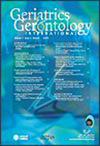Associations between body composition and hospitalization in patients undergoing maintenance hemodialysis
Abstract
Aim
Patients undergoing maintenance hemodialysis (MHD) often have multiple comorbidities and are vulnerable to minor stressors that frequently result in hospitalization. Recent advances have enabled the easy estimation of body composition in clinical settings. This study retrospectively investigated changes in body composition associated with hospitalization in patients receiving MHD.
Methods
Body composition was measured every 6 months using a multifrequency bioelectrical impedance analysis (BIA) device in outpatients with MHD. Hospitalization events lasting >24 h were reviewed throughout the follow-up period.
Results
Overall, 166 patients (94 men [56.6%]) underwent 904 BIA measurements. A higher baseline extracellular water to total body water ratio (ECW/TBW) and lower phase angle (PhA) were associated with increased hospitalization risk. During the study period, 272 hospitalizations were recorded. Compared with those without hospitalization, hospitalized patients showed progressive declines in fat-free mass index, skeletal muscle mass index, and PhA, along with an increase in ECW/TBW. These trends were consistent across subgroups based on the number and duration of hospitalizations; however, an increase in visceral fat area was observed in patients with four or more hospitalizations. Among the 89 patients who were hospitalized between measurements, body composition was compared pre- and post-hospitalization, with the results revealing significant decreases in body mass index, percent body fat, and PhA, and an increase in ECW/TBW.
Conclusions
Body composition is closely associated with hospitalization in patients undergoing MHD. Efforts to maintain euvolemic status and active interventions such as nutritional support and rehabilitation therapy may be essential to preserve a favorable body composition in this vulnerable population. Geriatr Gerontol Int 2025; 25: 1389–1396.


 求助内容:
求助内容: 应助结果提醒方式:
应助结果提醒方式:


